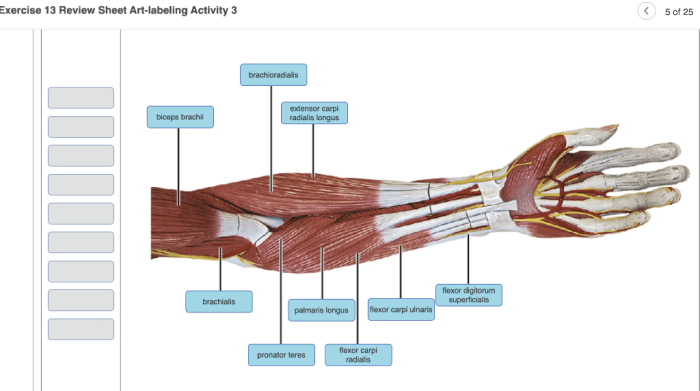Embarking on Exercise 13 Review Sheet Art-Labeling Activity 2, we delve into an immersive learning journey that seamlessly blends art and science. This innovative activity not only reinforces the concepts covered in Exercise 13 but also fosters a deeper understanding of the subject matter through hands-on engagement.
Through the lens of art, students engage with the content in a novel and meaningful way, solidifying their grasp of key topics and concepts. The art-labeling aspect serves as a catalyst for critical thinking, analysis, and creative expression, transforming the review process into an enriching and unforgettable experience.
Overview of Exercise 13 Review Sheet

The Exercise 13 Review Sheet is a comprehensive resource designed to reinforce the concepts and skills covered in Exercise 13. It consists of a series of questions and activities that guide students through a thorough review of the material.
The review sheet is structured into sections that address key topics from the exercise, such as art history, art techniques, and art criticism. Each section includes a variety of questions, including multiple-choice, short answer, and essay questions.
The review sheet aims to achieve several learning objectives. First, it helps students to identify and understand the main concepts and theories presented in Exercise 13. Second, it encourages students to apply their knowledge by answering questions and completing activities.
Finally, it provides students with an opportunity to assess their understanding of the material and identify areas where they may need additional support.
Art-Labeling Activity 2
Art-Labeling Activity 2 is a hands-on activity that reinforces the concepts covered in Exercise 13. Students are presented with a series of artworks and asked to identify and label the different elements and techniques used in each work.
This activity serves several purposes. First, it helps students to develop a deeper understanding of the formal elements of art, such as line, shape, color, and texture. Second, it encourages students to analyze and interpret artworks, considering the artist’s intent and the context in which the work was created.
Content Analysis of the Review Sheet

| Section | Topics | Concepts | Examples |
|---|---|---|---|
| Art History | – Periods and styles
|
– Renaissance
|
– Leonardo da Vinci
|
| Art Techniques | – Drawing and painting
|
– Perspective
|
– “Mona Lisa” by Leonardo da Vinci
|
| Art Criticism | – Formal analysis
|
– Identifying the elements and principles of art
|
– Analyzing a painting by Pablo Picasso
|
Activity Evaluation and Improvement: Exercise 13 Review Sheet Art-labeling Activity 2

Art-Labeling Activity 2 is an effective activity for reinforcing the concepts covered in Exercise 13. It provides students with an opportunity to apply their knowledge and develop their analytical skills.
However, the activity could be improved by providing students with more guidance and support. For example, the instructions could include a brief overview of the formal elements of art and how to identify them in artworks.
Additionally, the activity could be made more challenging by asking students to analyze and interpret the artworks in more depth. For example, students could be asked to consider the artist’s intent, the context in which the work was created, and the cultural significance of the artwork.
Here is an alternative art-labeling activity that addresses the limitations of Activity 2:
Art-Labeling Activity 3
Students are presented with a series of artworks and asked to identify and label the different elements and techniques used in each work. Additionally, students are asked to write a brief analysis of each artwork, considering the artist’s intent, the context in which the work was created, and the cultural significance of the artwork.
This activity provides students with more guidance and support than Activity 2, and it also encourages them to analyze and interpret artworks in more depth.
FAQ Compilation
What is the purpose of Exercise 13 Review Sheet Art-Labeling Activity 2?
This activity aims to reinforce the concepts covered in Exercise 13 while fostering critical thinking, analysis, and creative expression through art.
How does art-labeling enhance the review process?
Art-labeling provides a unique and engaging way for students to interact with the content, deepening their understanding and retention of key concepts.
What are the benefits of integrating art into education?
Integrating art into education promotes creativity, visual literacy, and a holistic approach to learning, fostering a well-rounded and engaging educational experience.